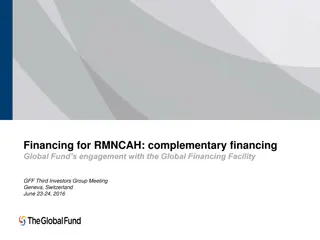Enhancing Alignment Between Health Financing and Public Financial Management Systems
Examining the alignment between health financing and public financial management systems is crucial for effective resource allocation towards priority populations and programs. This integration ensures that funds are directed efficiently, promoting Universal Health Coverage (UHC) goals. Challenges and areas for improvement in revenue collection, pooling, and other functions are highlighted in the context of health financing policy and PFM systems.
Uploaded on Jul 02, 2024 | 2 Views
Download Presentation

Please find below an Image/Link to download the presentation.
The content on the website is provided AS IS for your information and personal use only. It may not be sold, licensed, or shared on other websites without obtaining consent from the author.If you encounter any issues during the download, it is possible that the publisher has removed the file from their server.
You are allowed to download the files provided on this website for personal or commercial use, subject to the condition that they are used lawfully. All files are the property of their respective owners.
The content on the website is provided AS IS for your information and personal use only. It may not be sold, licensed, or shared on other websites without obtaining consent from the author.
E N D
Presentation Transcript
Integrated Framework and Process Guide A T O O L F O R E X A M I N I N G A L I G N M E N T B E T W E E N H E A LT H F I N A N C I N G A N D P U B L I C F I N A N C I A L M A N A G E M E N T S Y S T E M S Dar es Salaam, Tanzania 2016
More money for health will not get a country closer to UHC if funds cannot be directed to priority populations, programs, and services Health Spending in Ghana 44% 16% 40% Total Health Expenditure: National Health Insurance Scheme Ministry of Health Budget Out-of-Pocket Uninsured Inputs 4% Other services and medicines 38% 54% Services and medicines in the NHIS benefits package 4% Salaries Administration Service Investment Source: Schieber, Cashin and Saleh (2012). 2
Health Financing policy and PFM systems have the same ultimate goal PFM System Health Financing System Generation of Health Revenue Budget Formulation Accountability Efficiency Equity Pooling of Health Funds Budget Execution Service Delivery Purchasing of Health Services Budget Monitoring and Reporting Improved Population Health
The rules and systems governing the management of public funds can often be at odds with how health financing systems function.
Areas for improving alignment between health financing functions and PFM: REVENUE COLLECTION Implementation Conditions Financing Function PFM Functions PFM Challenges Unpredictable resource envelopes Revenue forecasting Budget formulation Budget classification by inputs rather than objectives, activities, and outputs Sufficient and stable resources to meet stated objectives Revenue collection Budget allocations separate from objectives and planning
Areas for improving alignment between health financing functions and PFM: POOLING Implementation Conditions Financing Function PFM Functions PFM Challenges Fiscal decentralization Fragmented revenue streams, input budgets, donor funds Mandate and mechanism to accumulate and redistribute funds Budget formulation Pooling With no mandate or mechanism to accumulate and redistribute
Distribution of government health spending under fiscal decentralization in Tajikistan 20 18 Per capita health expenditure (somoni) 16 14 Per capita government health spending across regions (2007) 12 10 8 6 4 2 0 Non-PHC PHC Source: Langenbrunner, Cashin and O Dougherty (2009).
Areas for improving alignment between health financing functions and PFM: PURCHASING Health Financing Function Implementation Conditions PFM Functions PFM Challenges Difficult to match health spending to needs and priorities Different purchasing arrangements and accounting for different revenue streams Mandate to purchase services for the population (benefits package, essential services, etc.) rather than infrastructure Budget classification Challenges to engagement with the private sector Purchasing Budget formulation Delays in the release of funds Lack of provider autonomy Poor information systems and monitoring capacity
What is good alignment between the PFM system & health financing policy?
MOH and MOF Joint Process to Improve Communication The over-arching questions to be answered through the Process Guide are: Do budgeting processes and PFM systems make it possible to: Process Guide contains Package of resources ENSURE SUSTAINABILITY - Allocate sufficient funds to the health sector to meet sector objectives and fulfill strategic plans given the macro-fiscal realities of the country ENSURE EFFICIENCY- Direct funds to priority populations, programs, and services at every step of the budget cycle (through pooling and purchasing arrangements) ENSURE ACCOUNTABILITY - Demonstrate that public spending on health reached priority populations, programs, and services and met stated objectives in the budget reporting and accountability systems A FRAMEWORK A SET OF BENCHMARKS for looking at alignment in different parts of the PFM system SAMPLE QUESTIONS
General purpose of this Process Guide To help guide a systematic dialogue between health and finance actors (MOH and MOF) to do three things: 3 2 3 1 2 To EXAMINE areas of misalignment and their consequences and PRIORITIZE among them for action To create a COLLABORATIVE ROADMAP for action that will allow countries to strengthen alignment For countries to be able to MONITOR PROGRESS on improving alignment
A closer Look: Descriptive Table - Allocation Within the Health Sector Characteristic of the Budget Formulation Process Current Situation Key Bottlenecks Basis of budgets within the health sector Integration/fragmentation in the health budget Allocation of health budgets across geographic, administrative and service delivery levels
Assessment: Placing alignment along a continuum ALIGNMENT CONTINUUM 2. Alignment Between Allocation of Budget to the Health Sector and Health Financing Objectives Alignment Between Allocation of Budget to the Health Sector and Health Financing Objectives Sector ceilings not based on strategic planning; final allocations not transparent allocations; some revenue sources excluded; donor funds fragmented Sector ceilings based on strategic planning; final allocations not transparent allocations; some revenue sources excluded; donor funds fragmented Sector ceilings based on strategic planning, reflect policy priorities, and are transparent allocations; some revenue sources excluded; donor funds partially integrated Sector ceilings based on strategic planning, reflect policy priorities, and are transparent allocations of a consolidated budget integrated across revenue sources; donor funds fully integrated 13
What we have learned through initiating the process in countries We have gotten to A HIGHER LEVEL OF UNDERSTANDING of what dialogue between health and finance means There is a demand for RESOURCES for MOH to become more prepared for the dialogue with finance DIALOGUE There is a need for some sort of a FRAMING or FOCAL POINT for the dialogue itself, and something systematic you can do with the information to inform the way forward
How can this align with existing processes in Tanzania? Synergies to existing health financing activities around the Health Financing Strategy and Single National Health Insurance To help identify preliminary implementation steps/preconditions that have to do with PFM to enable moving towards Single national HI (i.e. purchasing) Building on results and recommendations of existing studies, such as funding flows study Potential opportunity to integrate Process Guide to PFM working group that is forming, which could be a good entry point to eventually bringing the MOF and others to the table In the interim, this can continue to be housed with the HF TWG Putting MOF/MOH in the position to co-drive the process and build a platform for ongoing collaboration























